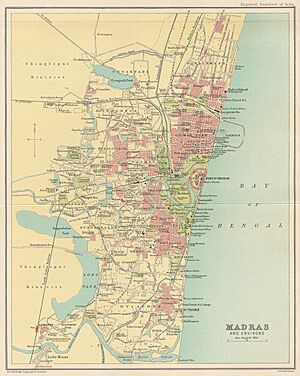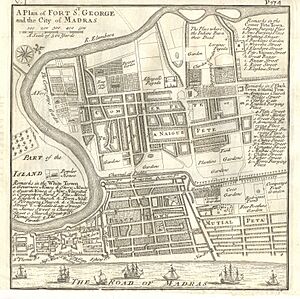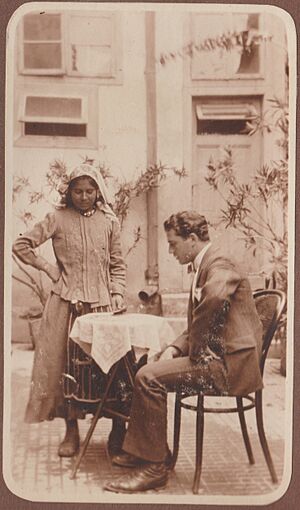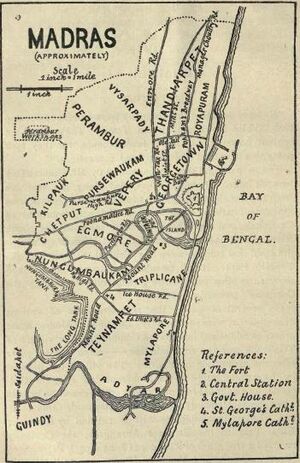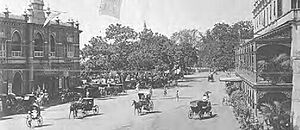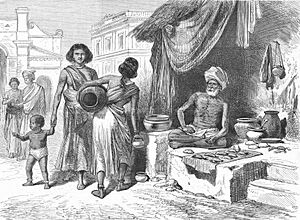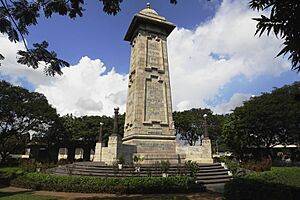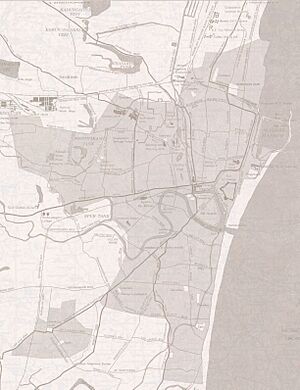History of Chennai facts for kids
Chennai, once called Madras, is the capital city of the Tamil Nadu state in India. It's India's fifth-largest city and sits on the Coromandel Coast by the Bay of Bengal. With over 12 million people, this 383-year-old city is one of the biggest in the world!
Chennai has a long and interesting past. It grew from a small settlement of the English East India Company during British rule into a major center for services and manufacturing in India today. Even before the city was founded, the area where Chennai now stands had a rich history with powerful South Indian empires.
Contents
Ancient History of Chennai
The area known today as Chennai was once part of a region called Tondaimandalam. This land was located between the Penna River and the Ponnaiyar River. Long ago, in the 1st century CE, early Chola kings ruled this region. Its capital city was Kancheepuram.
Some people believe the name "Madras" came from "Madharsa," which means a Muslim scholar's school, combined with "Pattinam," meaning a seashore area or city. Another old name for the area was Puliyur Kottam.
In the 2nd century CE, a Chola representative named Tondaiman Ilam Tiraiyan ruled Tondaimandalam. The modern city of Chennai began when the British set up a settlement called Fort St. George. They then expanded it by bringing together many local villages and European settlements. While the main part of Madras was built by Europeans, the surrounding areas included ancient temples like Thiruvanmiyur and Mylapore, which are over 2000 years old!
Chola and Pallava Rule
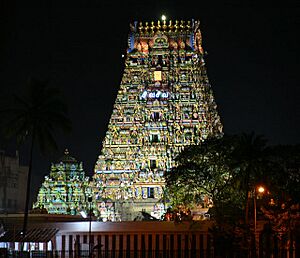
After Tondaiman Ilam Tiraiyan, the Chola Prince Ilam Killi ruled the region. However, the Satavahanas from the north took over, ending the Chola rule in Tondaimandalam. They appointed local leaders to manage the Kanchipuram area.
Later, the Pallavas became independent rulers of Kanchipuram and its surroundings. They controlled this region from the early 3rd century until the late 9th century. The Cholas, led by Aditya I, defeated the Pallavas around 879 CE and took control. Then, in 1264, the Pandyas under Jatavarman Sundara Pandyan became powerful and ended the Chola rule.
How Chennai City Began
The city we know as Chennai started in 1644 as a British settlement called Fort St. George. At that time, the region was part of the Vijayanagara Empire. The Vijayanagara rulers had local leaders called Nayaks who governed different areas almost independently.
Damerla Venkatadri Nayakar, a Nayak chieftain, was in charge of the area where Chennai is now. He was a powerful Nayak under the Vijayanagara King Peda Venkata Raya.
Getting the Land Grant
On August 20, 1639, Francis Day of the English East India Company met King Peda Venkata Raya to get permission for a small piece of land on the Coromandel Coast. They wanted to build a factory and warehouse for their trading business.
On August 22, 1639, Damerla Venkatadri Naick granted the East India Company a strip of land between the Cooum River and the Egmore River. This land was mostly wasteland.
On this land, Fort St. George was built. It was a protected settlement for British merchants and workers. The English then expanded their colony to include other European communities and local villages. One of these villages was called Mudhirasa pattanam, which some believe is where the name Madras came from.
However, it's widely known that the British named the entire combined city "Madras." This new city included "White Town" (mostly British settlers) and "Black Town" (mostly Catholic Europeans and Indian allies).
Early European Visitors
Chennai's story as a trading center began with different foreign powers. Its early growth was linked to its role as a port. In 1522, the Portuguese arrived and built a port they named São Tomé. They also fixed up a church and Saint Thomas's tomb in Mylapore.
Later, the Dutch took control of the region, setting up near Pulicat in 1612. Both the Portuguese and Dutch wanted to grow their populations, but even together, they were outnumbered by the local Indian people when the British arrived.
The British Arrive
By 1612, the Dutch had settled in Pulicat, to the north. In the 17th century, the English East India Company wanted to build a factory on the east coast. In 1626, they chose Armagon, a village north of Pulicat. However, the local cloth was not good enough for export, and the port was not suitable for trade.
Francis Day, an officer of the company, explored the coast in 1637 to find a better location.
Getting Permission from Rulers
At that time, the Coromandel Coast was ruled by Peda Venkata Raya of the Vijayanagara Empire. Under the King, local chiefs called Nayaks governed each district.
Damarla Venkatadri Naick was the local governor for the Vijayanagara Empire. He ruled the coastal area from Pulicat to San Thome. His brother, Ayyappa Naick, lived nearby and managed coastal affairs. Beri Thimmappa, Francis Day's interpreter, was a close friend of Ayyappa Naick. Ayyappa Naick convinced his brother to lease a sandy strip of land to Francis Day. In return, they promised trade benefits and protection.
Francis Day inspected the site at Madraspatnam and found it favorable. The cloth woven there was much cheaper than at Armagon.
On August 22, 1639, Francis Day received a grant from Damarla Venkatadri Nayakadu. This grant gave the East India Company a three-mile-long strip of land, including a fishing village called Madraspatnam. The company was allowed to build a fort and castle on about five square kilometers of this land for two years.
On February 20, 1640, Day and Andrew Cogan, along with soldiers and workers, arrived at Madraspatnam and started the new English factory. This date marks the first actual settlement of the English in the area.
Expanding Rights and Land
The initial land grant needed to be confirmed by the Raja of Chandragiri. In 1642, a new Raja, Sri Rangarayulu, took over. The grant expired, so Thomas Ivy, who replaced Francis Day, sent someone to get it renewed. A new grant was issued in October-November 1645.
This new grant was very important for the English settlement. It allowed the English to use their own laws for their colonists and for dealings with other Europeans, Muslims, and Hindus. It also expanded the Company's land by adding an area called Narimedu (or 'Jackal-ground') to the west of Madraspatnam village. This new grant helped Madras grow into the city it is today.
Growth of Fort St. George and Madras
Francis Day and Andrew Cogan are seen as the founders of Madras (now Chennai). They started building Fort St. George on April 23, 1640. Their small, fortified settlement quickly attracted other traders. By 1646, the settlement had grown to 19,000 people.
To make their position stronger, the Company combined various settlements around an expanded Fort St. George. This area became known as the Fort St. George settlement. The British and other Christian Europeans were only allowed to paint their buildings white, so the area became known as 'White Town'.
Only Europeans, mainly British Protestant settlers, were allowed to live in White Town. Other groups, like French and Portuguese Catholics, had separate agreements to set up trading posts nearby. Over time, many Indians also arrived.
After some violence between Indian communities and Christian Europeans, White Town's defenses were expanded to include most of the Catholic European settlements. The non-European merchants and workers, mostly Muslim or Hindu, were resettled outside this new "White Town." This new area was called "Black Town." Together, the original Fort St. George settlement, "White Town," and "Black Town" were named Madras.
Over the years, the city faced challenges like disease and wars, which reduced its population. Each time, survivors found safety within Fort St. George. Because of frequent attacks, the Fort became the main center around which the city rebuilt itself. The Fort still stands today, and part of it houses the Tamil Nadu Legislative Assembly. Elihu Yale, who gave money to start Yale University, was a British governor of Madras.
The city's borders changed many times due to attacks from surrounding powers. For example, in 1646, Golkonda forces conquered Madras, but the Fort remained under British control. They slowly rebuilt their colony. By 1674, the expanded colony had almost 50,000 colonists and was officially recognized as a modern city.
After Golkonda fell in 1687, the region came under the rule of the Mughal Emperors. They gave new permissions and borders for the area. This meant local rulers could no longer officially attack the British. Madras grew steadily under the East India Company. Many British and Anglo-American settlers arrived, and during the time of Governor Elihu Yale (1687–92), the city formed a mayor and a Corporation for self-governance.
In 1693, the towns of Tondiarpet, Purasawalkam, and Egmore were added to the Company's control. Parts of Chennai today, like Poonamalee and Triplicane, are mentioned in ancient Tamil writings from the 6th-9th centuries. Thomas Pitt became Governor in 1698, and during his eleven years, trade grew, and many fine houses, a larger port, new city walls, churches, and schools were built.
Areas Added to Madras
| Village | Year |
|---|---|
| Madraspatnam | 1639 |
| Narimedu (west of Madraspatnam) | 1645 |
| Triplicane | 1672 |
| Tiruvottiyur | 1708 |
| Kottivakkam | 1708 |
| Nungambakkam | 1708 |
| Egmore | 1720 |
| Purasawalkam | 1720 |
| Tondiarpet | 1720 |
| Chintadripet | 1735 |
| Vepery | 1742 |
| Mylapore | 1749 |
| Chennapatnam | 1801 |
From 1750s to British Rule End
In 1746, Fort St. George and Madras were captured by the French under General La Bourdonnais. The French damaged the village of Chepauk and Blacktown.
The British got control back in 1749 through a peace agreement. They then made Fort St. George stronger over the next thirty years to withstand future attacks. The strongest attacks came from the French in 1759 and later from Hyder Ali, the Sultan of Mysore, in 1767. After a peace treaty, threats to Madras decreased. The Fort St. George you see today is largely the one built in 1783.
In the late 1700s, Madras became an important British naval base and the center for British rule in southern India. The British fought with other European powers, like the French and Danish, eventually dominating the region. They also fought four wars with the Kingdom of Mysore, which led to their control over South India. Madras became the capital of the Madras Presidency.
By the end of 1783, the British were in complete control of Madras and most of South India. They expanded the city by adding nearby villages like Triplicane, Egmore, Purasawalkam, and Chetput. This new area was called Chennapatnam by locals. Over time, this area was fully included into the city of Madras.
The development of a harbor made Madras an important trade center between India and Europe in the 18th century. Many famous companies started here, like EID Parry (one of the oldest in the country), Binny & Co (a textile company), and Spencer's, which became one of Asia's biggest department stores.
In 1836, the Madras Chamber of Commerce was founded, helping to open up trade. The Madras Stock Exchange was set up in 1920. In 1906, a major bank failed, but Indian Bank was founded the next year by a group of Indian merchants, helping to fund new Indian businesses.
During World War I, Madras was attacked by a German ship, the SMS Emden, causing some deaths and injuries.
Chennai Since India's Independence (1947)
After India became independent in 1947, Madras became the capital of Madras State. This state was later renamed Tamil Nadu in 1968.
In 1953, when states in India were reorganized based on language, Telugu speakers wanted Madras to be the capital of their new state, Andhra Pradesh. However, because Tamils had strong political influence, Madras remained part of Tamil Nadu.
Over time, the number of British and European people in Madras decreased. As more and more Indians moved to the city for work, the British became a smaller part of the population. When India gained independence in 1947, the city's leadership naturally shifted to the larger Indian population.
Today, Chennai is a diverse city. It's home to Anglo-Indian descendants of early English settlers, a smaller British and European community, and many people from other parts of India like Bengalis, Punjabis, and Gujaratis. Chennai also has a growing number of people from other countries, especially from the United States, Europe, and East Asia, who work in the city's growing industries and IT sectors.
English was the official language of the city since its founding in 1639. However, in the 1960s, there were protests against the central government's push to use Hindi more. Chennai also saw violence related to the Sri Lankan Civil War in the 1980s and 1990s. In 1991, former Prime Minister Rajiv Gandhi was assassinated near Chennai.
In 1996, the government of Tamil Nadu officially changed the city's name from Madras to Chennai. The 2004 tsunami also hit Chennai's shores, causing many deaths.
Today, Chennai is a big cultural, commercial, and industrial center. It's famous for its cultural heritage and beautiful temples. Chennai is known as the "automobile capital of India" because about 40% of India's car industry is based here. It's also a major center for IT and financial services. Because of its rich music and cultural traditions, UNESCO has included Chennai in its Creative Cities Network.
City Name Origin
There are different ideas about where the name Chennai came from. A popular idea is that it's named after Damarla Chennappa Naick, who was the father of Damarla Venkatadri Naick. The English bought the town from Venkatadri Naick in 1639. The name Chennai is said to have first appeared in a sale document on August 8, 1639.
The city's older name, Madras, is also debated. But most agree it's a shorter version of Madraspatnam, the place the British East India Company chose for their settlement in 1639.
Locals used to call the area by different names like madrapupatnam, madras kuppam, and madraspatnam. Another small town, Chennapatnam, was to the south. This place was supposedly named by Damarla Venkatadri Naick in honor of his father, Damarla Chennappa Naick.
The first grant from Damarla Venkatadri Naick mentions Madraspatnam being part of the East India Company's land, but not Chennapatnam. This suggests that Fort St. George, the center of modern Chennai, was built near or on the village of Madraspatnam. Because the fort was so important to the city's growth, the British settlers later named their entire settlement Madras. It's unlikely the area was ever widely called Chennai before the official renaming.
See also
- Timeline of Chennai history
- List of people from Chennai
Images for kids
-
Raja Mahal Palace at Chandragiri from where Francis Day acquired permission from the King of Vijaynagara, Peda Venkata Raya


